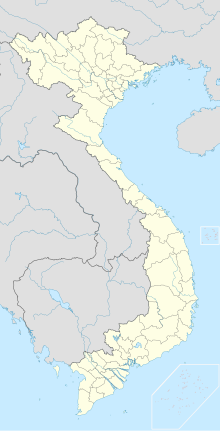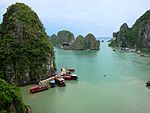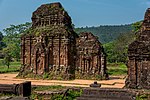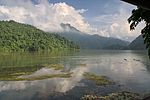
Hạ Long Bay or Halong Bay is a UNESCO World Heritage Site and popular travel destination in Quảng Ninh province, Vietnam. The name Hạ Long means "descending dragon". Administratively, the bay belongs to Hạ Long city, Cẩm Phả city, and is a part of Vân Đồn district. The bay features thousands of limestone karsts and islets in various shapes and sizes. Hạ Long Bay is a center of a larger zone that includes Bai Tu Long Bay to the northeast, and Cát Bà Island to the southwest. These larger zones share a similar geological, geographical, geomorphological, climate, and cultural characters.

On the first tier, Vietnam is divided into fifty-eight provinces (tỉnh) and five municipalities under the command of the central government. Municipalities are the highest-ranked cities in Vietnam. Municipalities are centrally-controlled cities and have special status equal to the provinces.

Phong Nha-Kẻ Bàng is a national park and UNESCO World Heritage Site in the Bố Trạch and Minh Hóa districts of central Quảng Bình Province in the North Central Coast region of Vietnam, about 500 km south of Hanoi. The park borders the Hin Namno National Park in Khammouane Province, Laos to the west and 42 km east of the South China Sea from its borderline point. Phong Nha-Kẻ Bàng National Park is in a limestone zone of 2,000 km2 in Vietnamese territory and borders another limestone zone of 2,000 km2 of Hin Namno in Laotian territory. The core zone of this national park covers 857.54 km2 and a buffer zone of 1,954 km2.

Biên Hòa is the capital city of Đồng Nai Province, Vietnam and part of the Ho Chi Minh City metropolitan area and located to the northeast of Ho Chi Minh City, to which Biên Hòa is linked by Vietnam Highway 1. Classified as a class-1 provincial city, it is the sixth largest city in Vietnam by population.

Quảng Bình is a southern coastal province in the North Central Coast region, the Central of Vietnam. It borders Hà Tĩnh to the north, Quảng Trị to the south, Khammouane of Laos to the west and the East Sea to the east.

Dong Hoi Airport is an airport located in Loc Ninh commune, 6 km north of Đồng Hới city, capital of Quảng Bình Province, in North Central Coast of Vietnam, about 500 km South-east of Hanoi by road. The facilities cover 173 ha, on a sandy area, by the coast of South China Sea. The runway approaches near the seashore and nearly parallel to the Highway 1. The airport, like all civil airports in Vietnam, is owned and operated by Airports Corporation of Vietnam.
Đặng Nhật Minh is one of Vietnam's foremost film directors. He began making documentary films around 1965 and is the first Vietnamese person to be awarded the Nikkei Asia Prize for Culture, in 1999. His films have won several prizes at international film festivals.

Tourism in Vietnam is a component of the modern Vietnamese economy. In 2019, Vietnam received 18 million international arrivals, up from 2.1 million in the year 2000. The Vietnam National Administration of Tourism is following a long-term plan to diversify the tourism industry, which brings foreign exchange into the country.
The Miss Universe Vietnam is a national beauty pageant in Vietnam to select the country's representative to the Miss Universe, one of the Big Four major international beauty pageants. It is held every two years.

Phạm Xuân Nguyên, better known by his pen name Ngân Xuyên, is a Vietnamese writer and literary translator.
Đàm Thanh Xuân is a former wushu taolu athlete from Vietnam. Currently, she now works at the Department of International Cooperation and General Department of Physical Education and Sports.

Professor Nguyen Dinh Duc is a Vietnamese scientist and currently serves as the Chairman of the University Council at the University of Engineering and Technology, Vietnam National University, Hanoi. He has made significant contributions in the field of new materials, particularly composites, Advanced Materials and Structures.

The 2021 Southeast Asian Games, officially known as the 31st Southeast Asian Games, 31st SEA Games or SEA Games 31, and also recognized as Viet Nam 2021, was the 31st edition of the Southeast Asian Games, the biennial regional multi-sport event which was held in Hanoi, Vietnam and its surrounding cities from 12 to 23 May 2022.
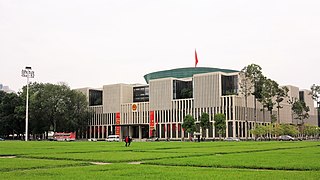
The National Assembly Building of Vietnam, officially the National Assembly House and also known as the New Ba Đình Hall, is a public building located on Ba Đình Square across from the Ho Chi Minh Mausoleum in Hanoi, Vietnam. Construction started on October 12, 2009, and finished on October 20, 2014. The building is used by the National Assembly of Vietnam for its sessions and other official functions.

The seals of the Nguyễn dynasty can refer to a collection of seals specifically made for the emperors of the Nguyễn dynasty, who reigned over Vietnam between the years 1802 and 1945, or to seals produced during this period in Vietnamese history in general.

Huỳnh Nguyễn Mai Phương is a Vietnamese beauty pageant titleholder who was crowned Miss World Vietnam 2022. She represented Vietnam at the Miss World 2023 pageant.

The 5th Central Committee of the Communist Party of Vietnam (CPV) was elected at the 5th CPV National Congress. It elected the 5th Politburo and the 5th Secretariat.
